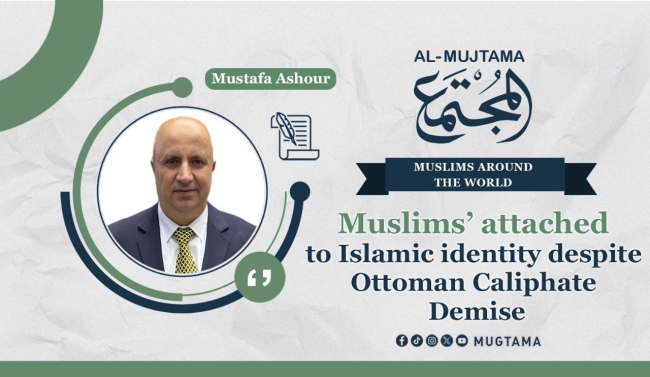Muslims' attached to Islamic identity despite Ottoman Caliphate Demise
On the 27th of Rajab, 1342 AH / March 3, 1924 CE, the Turkish National Assembly issued a decree abolishing the Ottoman Caliphate. This announcement was met with disdain in the Islamic world, and feeble attempts were made, which proved unsuccessful, to reinstate it. However, this powerful and painful fall resulted in identity tensions, ranging from Turkey itself to the Muslim minorities in Europe and Asia, to regions with Muslim majorities. This marked the beginning of a quest for a new identity.
Islam had already been excluded from the formation of Turkish identity by a superior decree in 1924, in an effort to construct a Turkish nationalist identity to replace the Islamic one. In the late 19th century, “Turanism” emerged as a secret nationalist political movement, advocating for the unification of the Turkish element. Jews (1) played a role in its intellectual and organizational shaping. The movement considered Islam an obstacle to building Turkish identity, viewing it as exposing Turkish identity to non-Turkish components. Consequently, Turanism delved into the past to adopt its identity among the Mongol tribes in Asia.
Ataturk initiated a coercive erasure of Islamic and Ottoman identity through an authoritarian secular project, resulting in identity tensions
Upon Mustafa Kemal Ataturk's election as the President of Turkey in 1923, he began to coercively dismantle the Islamic and Ottoman identities through an authoritarian secular modernization project. This project excluded any Islamic manifestation in attire, laws, language, education, and state institutions. Ataturk perceived Islam as a central threat to the new Turkish identity, leading a repressive and eradication war against all Islamic identity elements. He sought to remove Islam from the public sphere by entirely severing ties with the Ottoman past, with all its achievements and failures.
Identity Tensions
However, Ataturk's eradicating approach towards Ottoman identity resulted in identity tensions in the new Turkey. Secret Islamic forces and movements emerged, preserving Islamic identity, practicing it outside state control, challenging coercive secularism, contradicting the new identity, and confronting internal separatist movements. One notable movement was led by Sheikh Said Piran, an uprising in Kurdish regions against Turkish rule that raised the slogan “Long live the Caliphate, down with the Republic.” Yet, it ended with Piran's execution on June 30, 1925, reflecting the tensions in Turkish identity imposed forcibly by Ataturk.
Secret Islamic movements emerged, preserving their identity
On the other hand, the new Turkish identity faced another challenge: accepting hundreds of thousands of people of Turkish origins who were expelled from their homelands due to their affiliation with Islam. Turkey received hundreds of thousands of people expelled from the Soviet Union, Greece, Yugoslavia, and the Balkans. The abolition of the Caliphate created an identity and existence crisis for many Muslim minorities in Asia and Europe, especially those from the Soviet Union, Greece, Albania, and the Balkans. These countries harbored deep animosity towards the Ottomans, resulting in a war against Islamic identity. This placed these minorities in an identity crisis with bitter choices: either renounce their Islamic identity and adopt a new one, whether Christian or communist, or face genocide or expulsion.
Europeans welcomed the return of a Christian European identity without the presence of any Islamic component within it. The European silence about the brutal repression suffered by these minorities exacerbated their suffering. Furthermore, most of the systems that emerged in the Balkans and Eastern Europe after the fall of the Caliphate were communist. A harsh war was waged against the Islamic identity of these minorities, aiming to distort and replace it. In Albania, although Muslims were the majority, King Ahmed Zog's regime, described as the “Ataturk of Albania,” followed Ataturk in combating Islamic identity by abolishing the hijab and Islamic education and fighting all aspects of Islamic identity.
Similarly, there were eradication processes for Islamic identity in the Balkans. Bulgaria signed an agreement with Turkey in October 1925, resulting in the mass deportation of many Muslims from Bulgaria to Turkey. Within ten years, 35% of Bulgaria's Muslims left their country, estimated at around 218,000. Another 384,000 were deported from Greece, and Turkish Muslims from Macedonia migrated to Turkey in 1924, with 305,000 expelled from Yugoslavia.
The new Turkish identity faced challenges in accepting Muslim Turks expelled from their homelands
According to Turkish statistics, over 800,000 people from the Balkans migrated to Turkey between 1923 and 1945. Not to mention migrations from East Turkestan after the Chinese occupation.
Arab Nationalism
In the Arab region, the crises of the Ottoman Caliphate led to identity tensions. Initially, a crisis of identity emerged among the Christians of the Levant, who sought an identity to belong to. They found their refuge in Arab nationalism, influenced by the German experience that used language as the focal point for building national identity. Secret Arab nationalist associations opposing the Turks and the Turkification policy emerged in the late 19th and early 20th centuries. In 1905, the book “Awakening of the Arab Nation” emerged as the first explicitly titled work using the term “the Arab Nation." Written in French by Naguib Azoury, it called for the separation of the Arabs from the Ottoman state.
A fusion of Arab nationalism and secularism was orchestrated to construct a novel identity, inspired by Ataturk's experiments
Arab nationalist and secular ideas were integrated with modernization to construct a new Arab identity. With the abolition of the Caliphate, some national identities began to form, especially with the emergence of independent states. Some Arabs drew inspiration from Ataturk's ideas by distancing themselves from Islam in nation-building identity. The Nationalist state turned into an instrument to dismantle identity, often resorting to violence to suppress other identities.
However, the newly established national identity failed to serve as a pot for diverse identities in society. Thus, tensions were profound, and suppression was severe. The decisive blow to nationalism as an alternative identity came with the collapse of Syrian-Egyptian unity in 1961. This separation had a similar impact on nationalism as the collapse of the Caliphate in 1924. Following the disintegration of the United Arab Republic in 1961, Arabs turned to searching for identities specific to each country rather than seeking a common identity.
-------------------------------------------------------------------------------------------------------------------------------------------------
- (1) Among the notable Jews who formulated the theoretical framework for Turanism was the Hungarian Arminius Vambery, who explicitly said, “Islam contradicts nationalism.” Another Jewish figure, the German Albert Cohen, who operated under a Turkish name, Tegin Alp, asserted, “We must be ourselves... Our entire generation is not Turkish, and it must be established and reformed on new foundations.”


